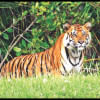A Serene Beauty

To get to Sundarban Reserve Forest, one usually starts early in the morning from Khulna's Rupsha river by boat. As the day wears on, the urban sprawl of the Rupsha's banks gradually change to rural greenery. Houses, factories and godowns are replaced by village homes, trees and cropland. River traffic becomes lighter as smaller boats replace the larger ships.
Around early afternoon – depending on the tide - your boat takes a wide U-turn on the river. You notice that the land on your left has become an elongated wedge-shaped strip with water on both sides. This is the village of Bania Shanta, also known as Joymoni, a fishermen's village. You watch the village – with its small boats, children playing and women working on the verandas of their homes on stilts - until it recedes into the distance.
And then you are in the forest.
This is not immediately obvious because you are not surrounded by trees. The river is wide, and the trees on both sides are thinner and shorter than you would expect in a normal forest. This is a feature of mangrove forests, where trees must work extra hard to extract nutrition from the saline soil. There are, however, no houses, no people, and very few boats.
As you go deeper and deeper into Sundarban, its serene beauty captures you.
At first it is the little things. On the river, instead of the floating rubbish polluting urban rivers you find ever-changing tapestries of multicoloured leaves accompanied by an occasional black pod, a Sundari seed. The sky above you becomes infinitely big and wide. You spot an osprey – hunter of fish – flying off with a large catch. The air feels fresh on your skin.
By the end of the day you are immersed in the forest, with your launch anchored at a suitable point. You board the small rowboat that was towed along and enter a narrow creek. A series of nypa palms with large leaves - red, yellow and green - lines one bank. Colourful kingfishers fish from branches extending over the water. A clawless otter crosses the canal, stops to look at your boat and scratches his nose before disappearing into the jungle.
At a curve the riverbank swells like a belly, white and pockmarked with protruding mangrove roots. A shikra – bird of prey - dives into the roots, picks a finger-sized mudskipper fish with its beaks, and flies off into the forest. A nervous red fiddler crab rushes into its hole.
Keeping your eyes on the muddy banks, you see the tracks of different animals - deer, otters, birds – that have crossed the water. Then you see a larger set of prints, a tiger's pug marks, much easier to find than a real tiger. Jim Corbett could tell the tiger's age, gender and size from its pug mark, but for you just seeing it, still fresh because the tide hasn't washed it away, is exciting.
Mesmerised by the forest, you try to imagine it changing with seasons. Summer brings heat, humidity, but also numerous flowers which draw the Sundarban honeybees. With monsoon's rains the forest's greens saturate even more. Autumn and winter mornings are often covered in fog.
And on a clear winter day like today it looks like paradise on earth.
www.facebook.com/ikabirphotographs or follow ihtishamkabir on Instagram

 For all latest news, follow The Daily Star's Google News channel.
For all latest news, follow The Daily Star's Google News channel. 








Comments